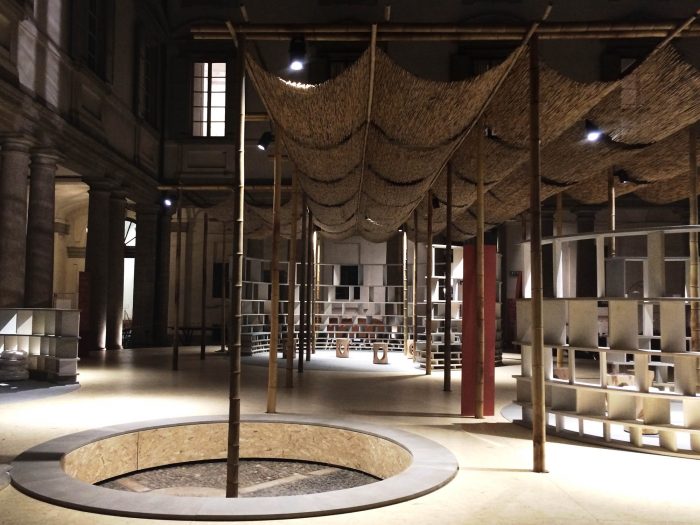Diébédo Francis Kéré在米兰历史悠久的宫殿Palazzo Litta中创造了一个被野草环绕的石头和木头亭子。
Diébédo Francis Kéré has created a stone and wood pavilion encircled by wild grasses in the Palazzo Litta, a historic palace in Milan.
从典型的非洲村落的社会和空间动态中得到启发,庭院村旨在为游客之间的社会接触和聚会开辟道路。定义这个公共场地的是一个高架平台,周围是意大利本地的草丛。在平台上,矗立着三个开放的、由石头制成的圆形庇护所,其形状和材料性双重表达了一种透明感和质量感。在头顶上,一个由竹子组成的独特的悬垂屋顶保护并遮蔽着下面的村庄社区。
Taking cues from the social and spatial dynamics of a typical African village, the Courtyard Village aims to carve paths for social encounter and gathering among visitors. Defining this communal ground is an elevated platform surrounded by a ground cover of native Italian grasses. Atop the platform stand three open, circular shelters made of stone, whose shaping and materiality dually express a sense of transparency and mass. Overhead, a singular over-hanging roof of bamboo protects and shades the village community below.
装置中还展示了Kéré设计的第一把椅子。该作品被称为ZIBA,参考了非洲传统的凳子,用手工工具雕刻实心原木来塑造。ZIBA凳子由香柏制成,利用先进的数字技术重新诠释了这一过程。凳子的名字指的是一种俏皮的布基纳法索语,不鼓励闲置。这款作品是由Kéré为意大利专门生产实木家具的品牌Riva1920设计的。
The installation features the first chair designed by Kéré. Called ZIBA, the piece references traditional African stools that are shaped by carving solid logs with handmade tools. The ZIBA stool, made of scented cedar, reinterprets this process using an advanced digital technology. The name of the stool refers to a playful Burkinabé expression that discourages idleness. The piece was designed by Kéré for Riva1920, the Italian brand specializing in solid wood furniture.
意大利Casone公司制作了亭子的石雕,传达出一种轻盈和透明的感觉。”为了寻找材料的理想表达方式,Casone和Diébédo Francis Kéré的紧密合作旨在以创新和大胆的方式重新诠释最原始的建筑方法–堆砌石头。”团队说。亭子里使用了六种石材,与历史悠久的宫殿和周围城市景观的材料和工艺产生了联系。著名的景观公司Euroambiente为展馆提供了意大利河流边自发生长的野草,以及竹秆。
The Italian company Casone produced the pavilion’s stonework, which conveys a sense of lightness and transparency. “In search of the ideal expression of material, the close collaboration between Casone and Diébédo Francis Kéré aims to reinterpret the most primitive construction method, piling stones, in an innovative and audacious way,” said the team. Six stone varieties were used in the pavilion, drawing connections to the materiality and craftsmanship of both the historic palace and surrounding cityscape. The renowned landscape company Euroambiente supplied the pavilion’s wild grasses, which grow spontaneously along Italian rivers, along with the bamboo stalks.
庭院占地500平方米,位于巴洛克风格的Palazzo Litta的中心。这座历史悠久的宫殿原为米兰的一个贵族家族所有,长期以来一直是文化和政治活动的重要场所。拿破仑-波拿巴、西班牙的玛格丽特-特蕾莎等人物的盛大宴会都曾在这里举行。”我非常喜欢Palazzo Litta建筑的力量,热情的庭院和宽敞的房间,在每一个角落你都能发现惊喜。”Kéré说。”这是一个展示当代设计的绝佳环境。”
Encompassing 500 square meters, the courtyard sits at the heart of the Baroque-style Palazzo Litta. Formerly owned by one of Milan’s noble families, the storied palace has long served as an important venue for cultural and political events. Grand parties for figures such as Napoleon Bonaparte and Margaret Theresa of Spain have taken place there. “I very much like the power of Palazzo Litta’s architecture, the welcoming courtyard and the spacious rooms where in every corner you discover surprises,” says Kéré. “This is an excellent setting in which to show contemporary design.”
庭院村是 “感知的问题。传统与技术”,探讨本土传统如何与现代技术并驾齐驱。该展览由比利时出版物《DAMn°》杂志和活动策划方Mosca Partners举办。该展览作为Fuorisalone 2016的一部分展出。
Courtyard Village is the centerpiece of the exhibition “A Matter of Perception: Tradition and Technology,” which explores how homegrown traditions go hand in hand with modern technology. The show was organized by the Belgian publication DAMn° Magazine and the event planner Mosca Partners. The exhibition was on view as part of Fuorisalone 2016.
建筑师:Kéré Architecture
年份:2016年
摄影:Giovanni Desandre, Piercarlo Quecchia
城市: 米兰
国家:意大利
Architects: Kéré Architecture
Year: 2016
Photographs: Giovanni Desandre, Piercarlo Quecchia
City: Milan
Country: ITALY


















